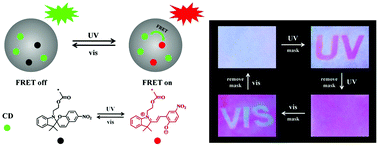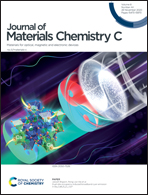Polymeric nanoparticles based on CDs with photoreversible dual-color fluorescence modulation†
Abstract
A new kind of photoswitchable polymer nanoparticle is prepared using polymerizable alkenyl carbon dots (PCDs) and a spiropyran derivative, together with methyl methacrylate (MMA) as the monomer, and mediated by one-pot miniemulsion polymerization. Switching between two different wavelengths of emitted light can be realized by intraparticle fluorescence resonance energy transfer (FRET). The FRET efficiency could be easily controlled by the feed ratios of the two chromophores and the excitation wavelengths. UV and visible light can be applied to modulate the fluorescence emission of the prepared nanoparticles. Upon visible light irradiation, the nanoparticles emit blue-green fluorescence of the CDs while spiropyran is in its closed form (SP). UV irradiation of SP gives rise to an open-ring isomer (MC). An SP-to-MC photoisomerization triggers a CD-to-MC FRET, and the resulting nanoparticles emit red light. Their fluorescence could be reversibly switched between blue-green and red by using UV/vis light irradiation with excellent photoreversibility and high stability. In addition, the novel nanoparticles with reversibly photoswitchable fluorescence could be directly applied in rewritable fluorescence patterning and dual-color fluorescence imaging of living cells.



 Please wait while we load your content...
Please wait while we load your content...